If you’ve been looking for a way to use your sourdough starter beyond bread loaves, this Sourdough Monkey Bread is pure magic. Soft, fluffy, and coated in buttery cinnamon sugar, it’s a sweet pull-apart bread made entirely with natural fermentation—no commercial yeast, just your bubbly sourdough starter doing all the work. It’s my go-to for a cozy weekend bake that feels indulgent but deeply homemade.

This recipe can also be adapted into sourdough discard monkey bread. But that will require some augmentation with commercial yeast.
Jump to:
👩🏽🍳 Why You’ll Love This Sourdough Monkey Bread
- No yeast, no discard—just your bubbly sourdough starter doing all the magic! This recipe is naturally leavened, making it a great way to embrace slow, mindful baking.
- Soft, fluffy, and pull-apart perfection with every bite—coated in warm cinnamon sugar and drenched in sticky caramel sauce.
- It’s a show-stopping treat for brunch, holidays, or cozy weekends, yet surprisingly simple to make with pantry staples.
- A fun and delicious way to stretch your sourdough skills beyond crusty loaves—this will definitely become a family favorite!
🫙 Ingredient Notes & Substitutions
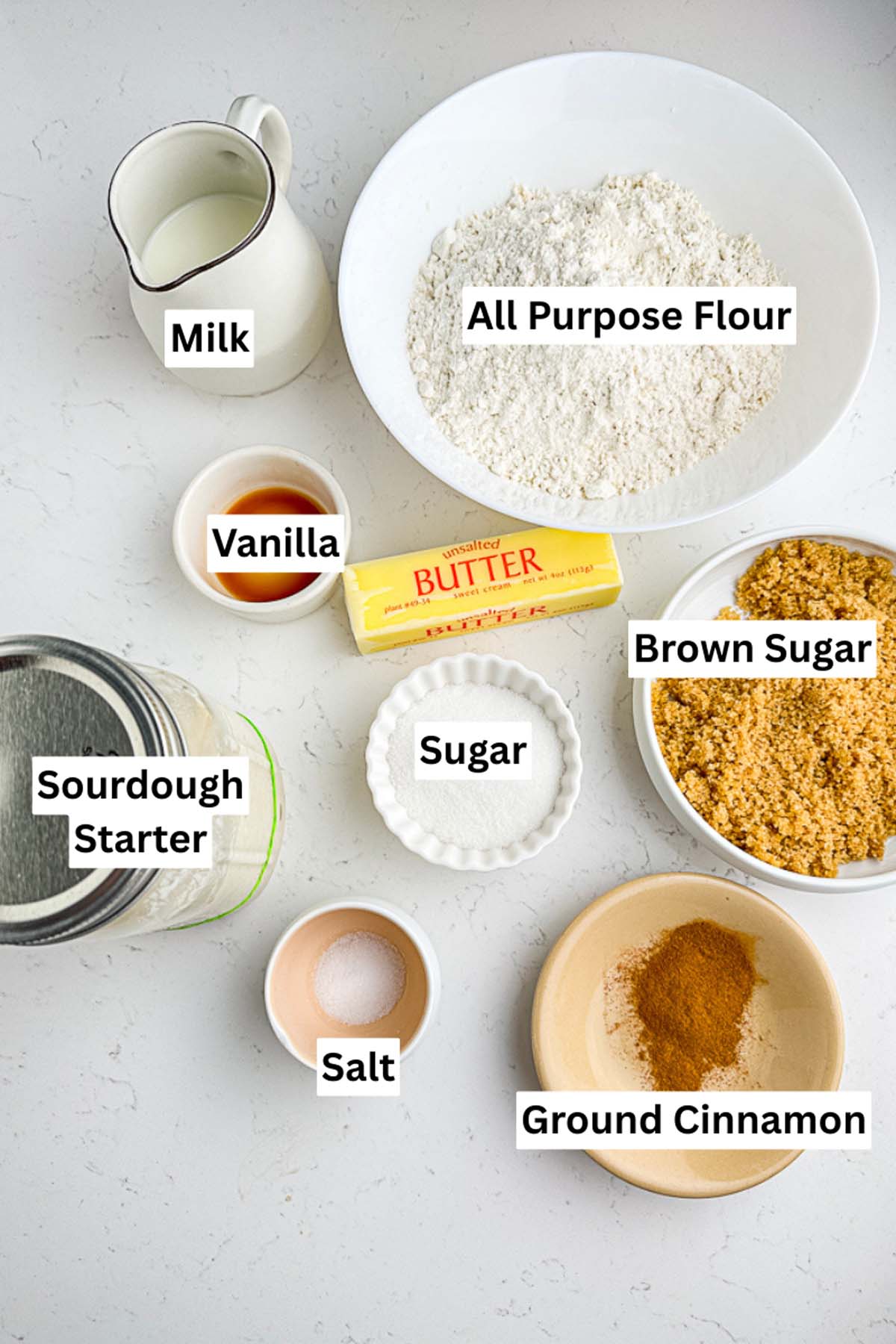
Ingredients for Dough
- All-Purpose Flour
I use regular all-purpose flour for a light, fluffy texture in this sourdough monkey bread recipe. You can substitute with bread flour if you want a chewier result, but keep in mind it may slightly alter the softness. For a whole grain twist, you can replace up to 20% of the flour with whole wheat flour—but be prepared for a denser texture. - Whole Milk
Whole milk adds richness and softness to the dough. You can use 2% milk if that’s what you have on hand, though the texture might be slightly less tender. For a dairy-free version, unsweetened almond milk or oat milk can work, but opt for full-fat versions for best results. Using plant-based milk for sourdough baking is a great option for lactose-intolerant bakers. - Active Sourdough Starter
This recipe relies entirely on wild yeast—no commercial yeast added—so a strong, bubbly, active sourdough starter is key. If you’re new to sourdough baking, make sure your starter has been fed within 4–6 hours and passes the float test. If your starter isn’t quite ready, your dough may take longer to rise or not rise enough. Looking for how to use active sourdough starter in enriched dough? This recipe is a perfect place to start! - Vanilla Extract
Pure vanilla extract adds a warm depth to the dough. You can skip it if needed, but I highly recommend keeping it in for that extra flavor boost. Vanilla bean paste is a great upgrade if you have it. - Sugar
Just a touch of sugar helps feed the sourdough and gives the bread a subtle sweetness. Regular white sugar works perfectly. Coconut sugar can be used as a more natural alternative, though it may darken the dough slightly. - Salt
Fine sea salt or table salt is fine here. Don’t skip it—salt balances the sweetness and strengthens the dough structure.
Ingredients for Cinnamon-Sugar Coating
Sugar + Ground Cinnamon
This classic combo gives monkey bread its signature cozy flavor. Use white granulated sugar and good-quality ground cinnamon. For a warmer, spicier note, try Ceylon cinnamon instead of cassia.
Ingredients for Brown Sugar Sauce
- Butter
One stick of unsalted butter gives the sauce its rich base. If you only have salted butter, just reduce the salt in the dough slightly. For a dairy-free version, a vegan butter substitute like Miyoko’s or Earth Balance works well. - Brown Sugar
Brown sugar adds moisture and that irresistible molasses flavor. Light or dark brown sugar both work—dark will make a deeper, more caramel-like sauce. Coconut sugar or date sugar can be used in a pinch but will change the flavor profile.
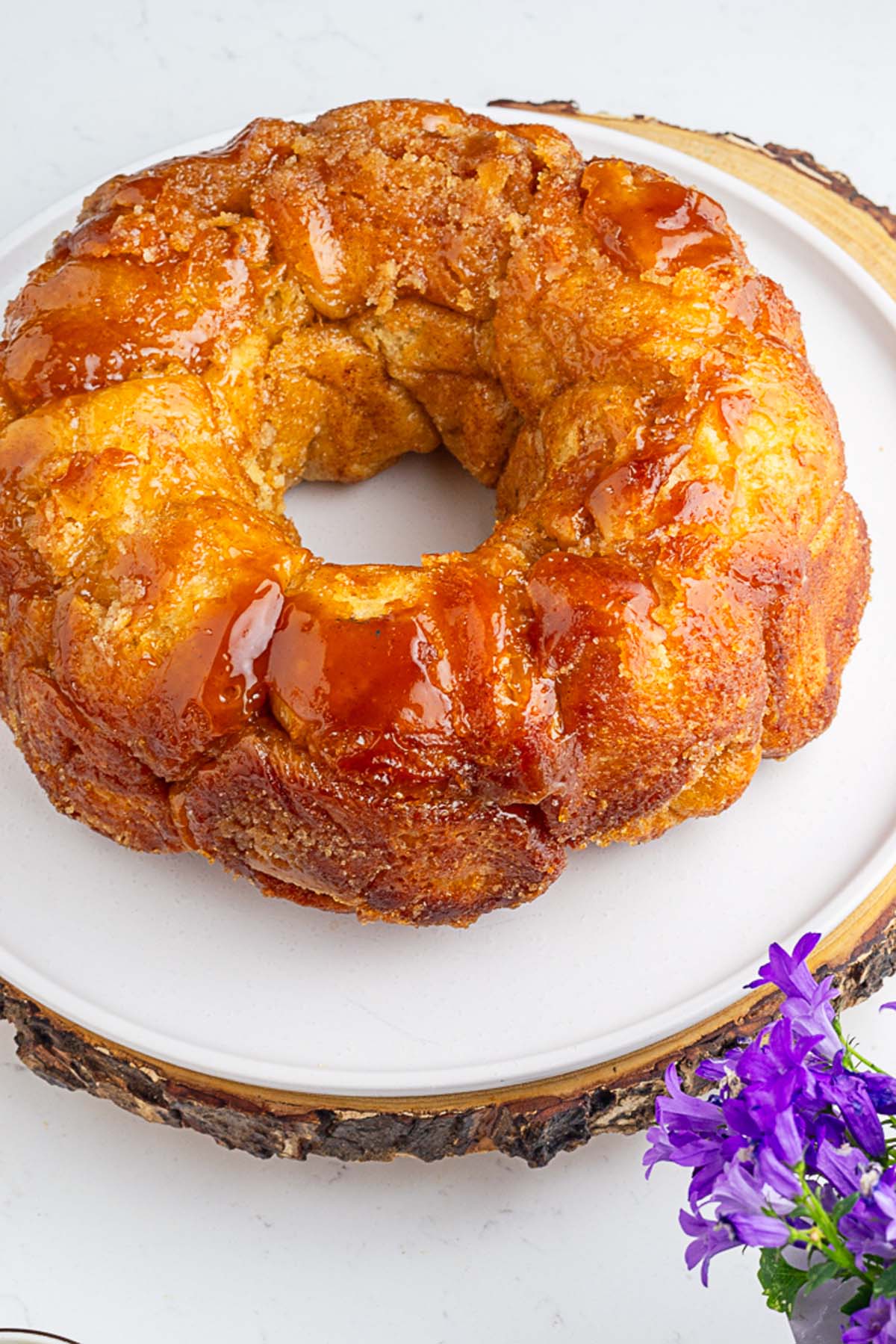
🔪 Instructions for making Sourdough Monkey Bread
1. Make Bread Dough
Kneading with hands
In a large mixing bowl, combine your active sourdough starter, whole milk, sugar, and vanilla. Stir until everything is well mixed, then gradually add the flour mixed with salt. Use a dough whisk or your hands to bring the dough together—it’ll feel a bit sticky at first, and that’s perfectly fine. Avoid adding too much extra flour.
Cover and let it rest for 20–30 minutes to hydrate (this is called autolyse). Then, begin kneading by pressing the dough away from you with the heel of your hand, folding it back, and turning it 90 degrees. Repeat this motion rhythmically for about 8–10 minutes, or until the dough becomes smooth, elastic, and slightly tacky but not sticky. If the dough tears easily, it needs more kneading.
Avoid adding too much flour; a lightly floured surface or damp hands can help manage stickiness without altering the dough’s hydration. Once the dough is well-kneaded, shape it into a ball and place it in a greased bowl to begin the bulk fermentation.
Kneading dough in a stand mixer
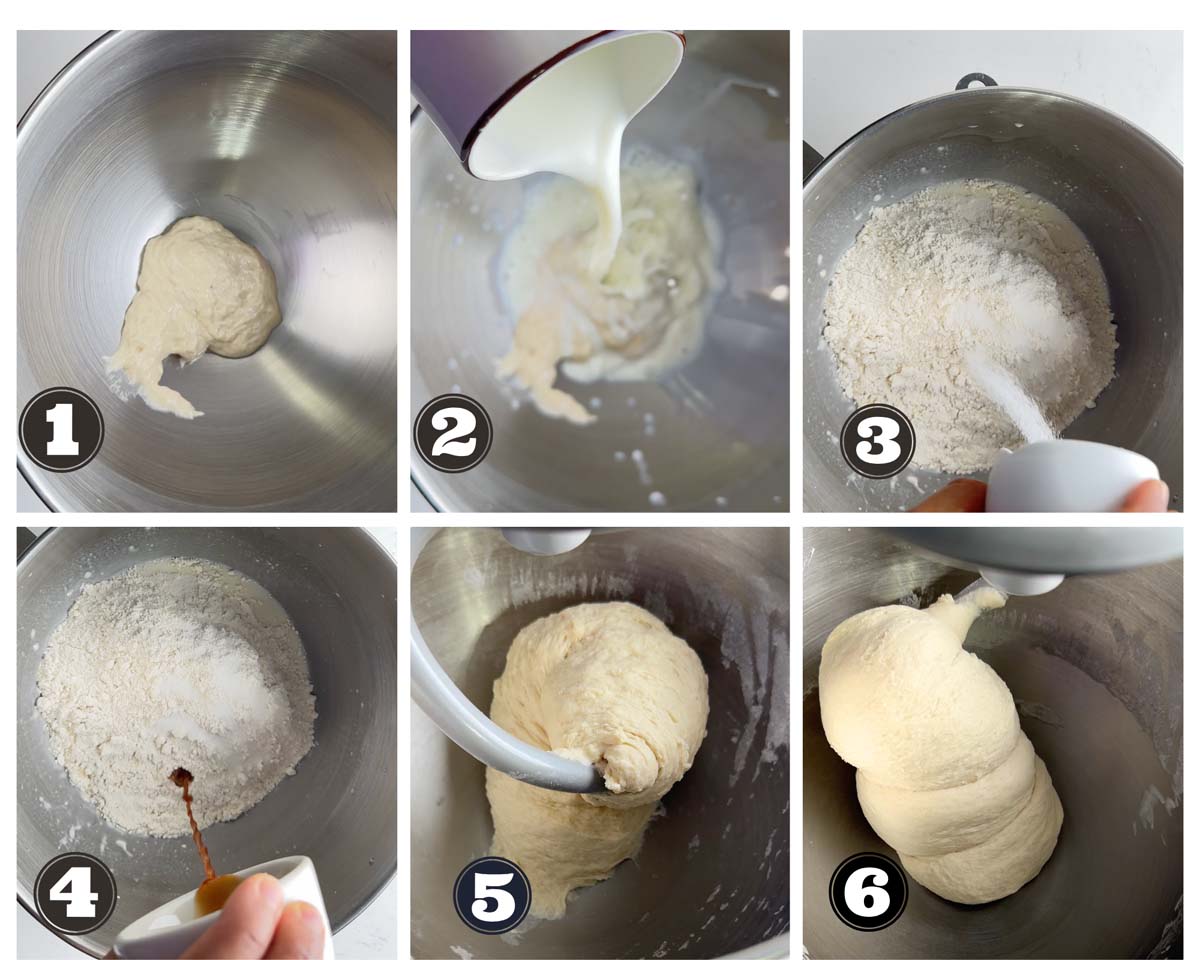
If you're using a stand mixer, combine the active starter with milk, vanilla, and sugar in the bowl of a stand mixer. Now add flour and salt. Mix on low speed with the dough hook attachment until just combined. Let the dough rest for 20–30 minutes for autolyse. After resting, knead the dough on medium-low speed (speed 2) for about 5–7 minutes. Stop occasionally to scrape down the sides and check the dough’s texture. It should pull away from the sides of the bowl and form a soft, elastic ball that passes the “windowpane test” — when a small piece can be stretched thin without tearing.
Once the dough is ready, transfer it to a lightly greased bowl for bulk fermentation. Whether kneading by hand or with a mixer, patience and gentle handling will help develop the gluten structure needed for fluffy, pull-apart Monkey Bread.
2. Bulk Ferment
Once kneaded, place the dough into a lightly greased bowl, cover it, and let it bulk ferment at room temperature (around 22–24°C / 72–75°F) for 6–8 hours, or until it has doubled in size and feels airy. If your kitchen is cooler, it may take a bit longer.
3. Shape into little dough balls or pieces
Once the dough has risen, turn it out onto a clean surface and gently deflate it. Roll it into a thick piece of dough. Now, use a bench scraper or something similar to divide it into small bite-sized pieces. You can also roll it to form small dough balls.
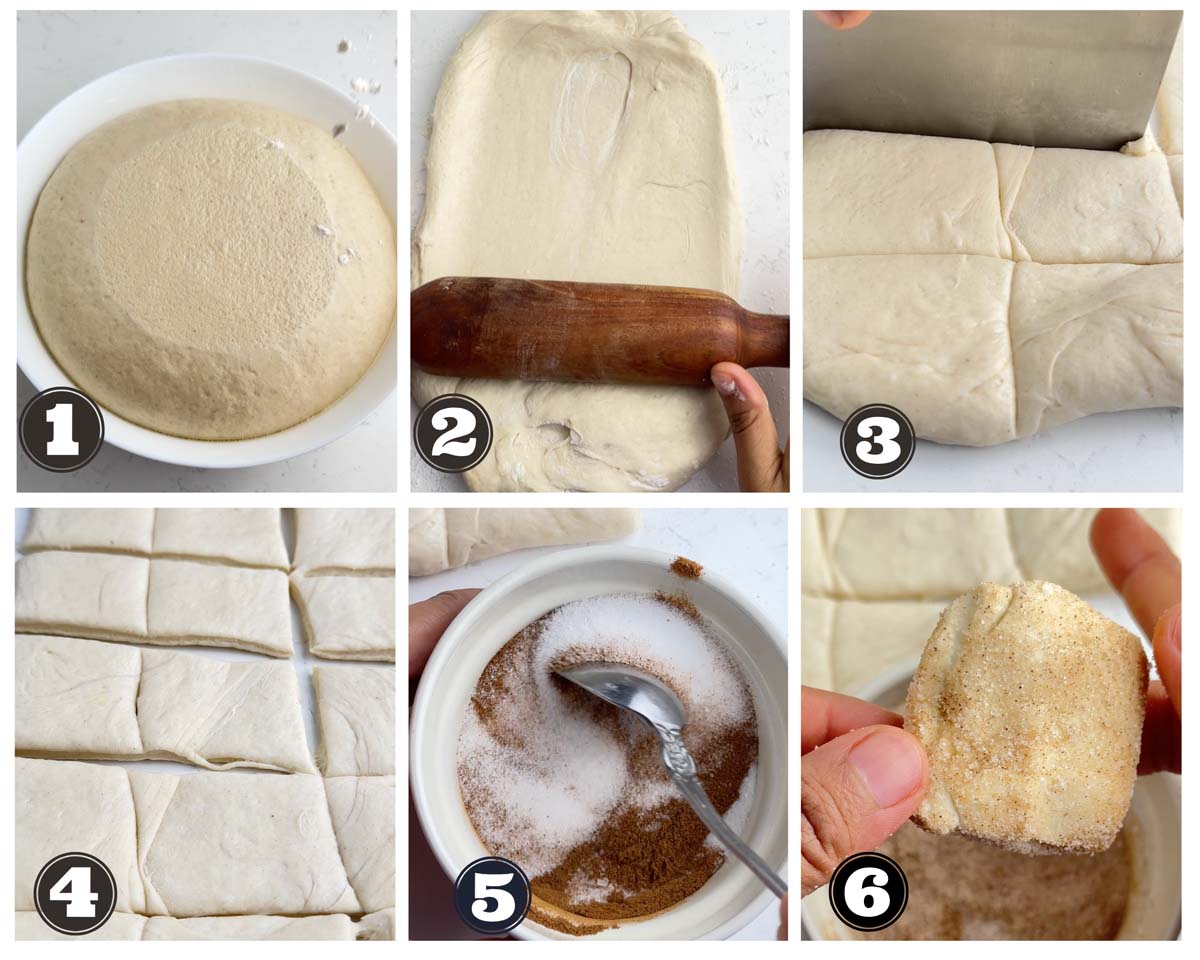
In a small bowl, mix the sugar and cinnamon for the coating. Roll each dough piece in the cinnamon sugar mixture until well coated. This cinnamon-sugar layer gives that classic monkey bread texture and flavor.
4. Assemble the Monkey Bread
Grease a bundt pan or a tall cake tin with butter or oil. Layer the cinnamon-sugar dough pieces in the pan, scattering them evenly to create little pockets that will bake into a pull-apart masterpiece.
5. Prepare the brown sugar Sauce
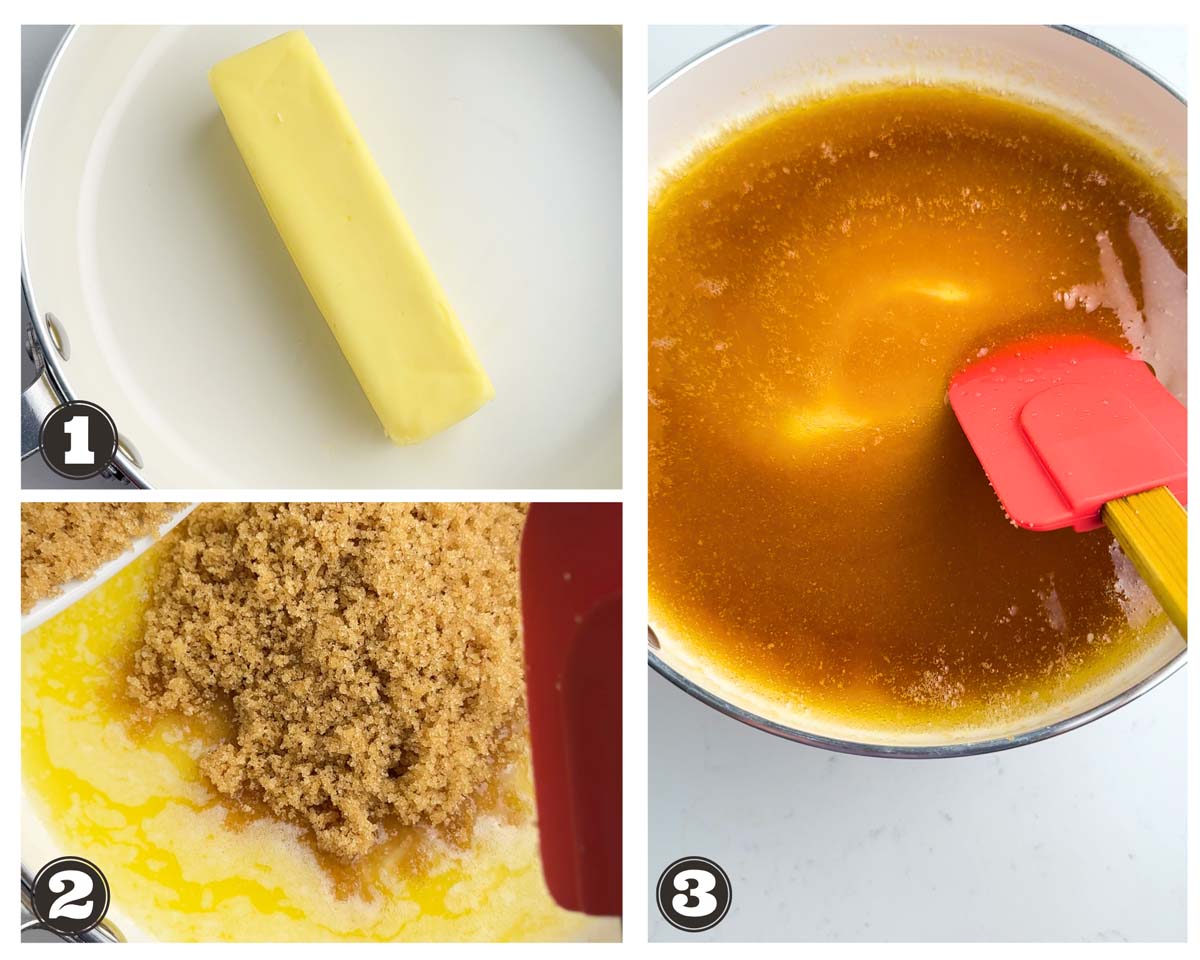
In a saucepan, melt the butter and turn off the heat. Now add brown sugar and stir until it combines with the melted butter. The mixture should become glossy and pourable. Let it cool slightly if it became hot while melting. It should still be slightly warm when you pour it over the dough but not hot.
Once all the dough balls are in, pour the warm caramel sauce over the top, letting it seep down through the layers. Give the pan a gentle shake to help it settle.
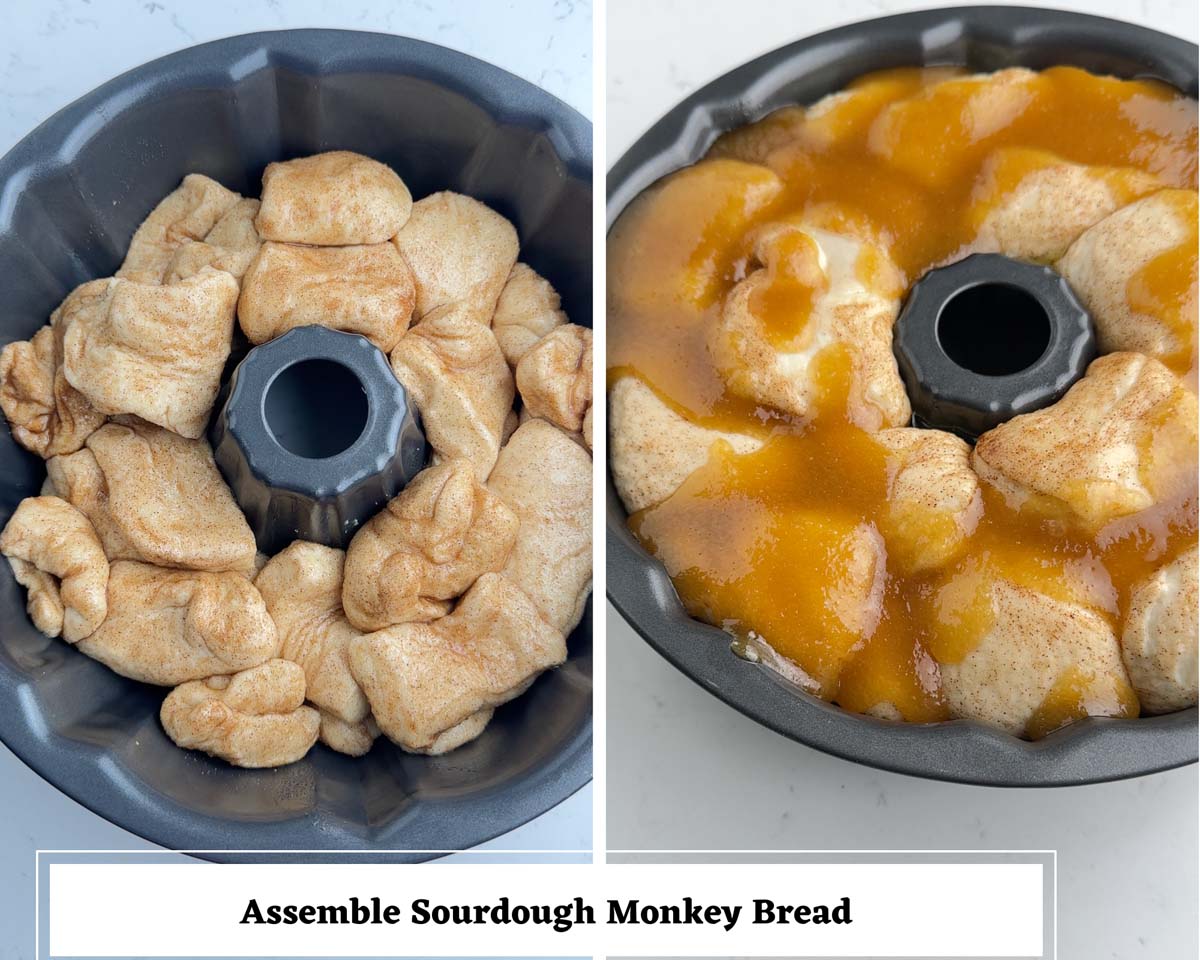
6. Final Proof
Cover the pan loosely with a lid or damp towel and let the assembled sourdough monkey bread proof at room temperature for 2–3 hours, or until the dough has puffed up noticeably. If your kitchen is cooler, give it a bit more time—you’re looking for soft, pillowy dough that springs back slowly when touched.
7. Bake
Preheat your oven to 180°C (350°F). Once fully proofed, bake the monkey bread in the center of the oven for 35-38 minutes, or until the top is golden brown and the caramel is bubbling around the edges. If the top is browning too quickly, tent it loosely with foil halfway through baking.
8. Cool and Serve
Let the bread cool in the pan for 10–15 minutes before carefully inverting it onto a serving plate. The sticky caramel should coat the outside beautifully. Serve warm for the best gooey texture—perfect for pulling apart with your hands and sharing.
📝 Tip for Perfect and delicious Sourdough Monkey Bread
Before you dive into making your sourdough monkey bread with starter, here are a few helpful notes to make the process smoother and more foolproof—especially if you’re new to working with sourdough dough in enriched, sweet recipes.
- First and foremost, use an active and bubbly sourdough starter. If your starter isn’t rising well or has a sluggish aroma, your dough may not rise properly, especially since enriched dough (with butter, sugar, and milk) naturally ferments more slowly. If your dough isn’t rising after 4–6 hours, consider placing it in a warmer spot (around 75–78°F/24–26°C) or giving it a bit more time. Remember, fermentation time can vary depending on your kitchen temperature and the strength of your starter.
- If you’re looking for a substitute for dairy, you can replace whole milk with almond milk, oat milk, or soy milk. Unsalted plant-based butter also works well in place of regular butter. These swaps make it easy to create a dairy-free sourdough monkey bread without sacrificing flavor or softness.
- For a slightly quicker rise, you can add a pinch (¼ tsp) of instant yeast to sourdough monkey bread dough as a booster, especially in cooler environments. This won’t take away from the sourdough flavor but can give you more predictable results if you’re short on time.
- If the dough feels dense after baking, it may have been under-proofed. On the flip side, if it collapses or bakes up flat, it may have over-proofed.
- Want a different flavor profile? Swap the cinnamon sugar coating with a mix of brown sugar, cardamom, and orange zest for a unique twist. You can also fold in chopped nuts or raisins for added texture and flavor—just be careful not to overload the dough.
- Lastly, for those wondering why sourdough monkey bread turned out dry, it’s usually due to overbaking. Keep an eye on the oven during the final 10 minutes.
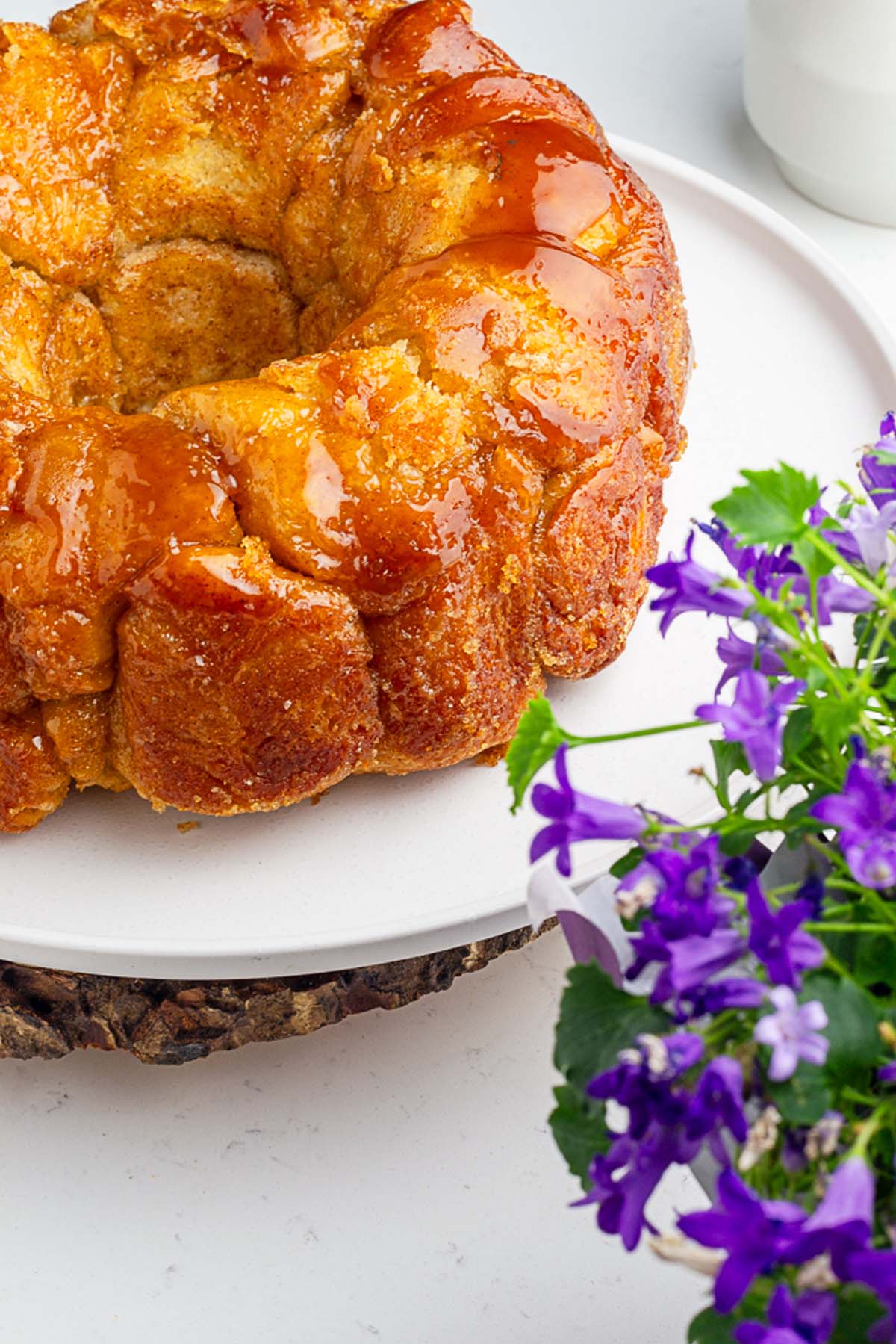
🔗 More sourdough Recipes
- Sourdough Blueberry bread
- Sourdough Hot Cross buns
- Sourdough Donuts
- Sourdough Cinnamon Rolls
- Sourdough chocolate bread
- Sourdough cinnamon raisin bread
- Pumpkin Sourdough
This Sourdough Monkey Bread is the perfect blend of tangy sourdough flavor and sweet, pull-apart goodness—just like a warm hug in every bite. Give it a try and let me know how your kitchen smelled when it came out of the oven!
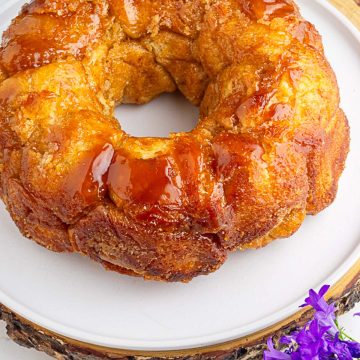
Sourdough Monkey Bread
Ingredients
Ingredients for dough
- 350 g All purpose flour (about 2¾ cups)
- 220 g Whole milk (about ¾ cup + 2 tbsp)
- 70 g active sourdough starter (⅓ cup)
- 1 teaspoon vanilla
- 2 teaspoon sugar
- ½ teaspoon salt
Ingredients for coating the dough pieces
- ⅓ cup sugar
- 1 tablespoon ground cinnamon
Ingredients For brown sugar sauce
- 1 stick butter (113 g)
- ¾ cup brown sugar
Instructions
Make Bread Dough
- Kneading with Hands:* In a large bowl, mix active sourdough starter, whole milk, sugar, and vanilla.* Gradually add flour mixed with salt. Combine using a dough whisk or your hands. Dough will be sticky—avoid adding extra flour.*Cover and rest for 20–30 minutes (autolyse).* Knead by pushing dough away with the heel of your hand, folding it back, and turning 90°.* Repeat for 8–10 minutes until dough is smooth, elastic, and tacky but not sticky.*Use a lightly floured surface or damp hands if needed.* Shape into a ball and place in a greased bowl for bulk fermentation.
- Kneading with a Stand Mixer* In a stand mixer bowl, combine starter, milk, vanilla, and sugar. Add flour and salt.* Mix on low speed with dough hook until just combined.* Cover and rest for 20–30 minutes (autolyse).* Knead on medium-low (speed 2) for 5–7 minutes. Scrape down sides as needed.* Dough should pull away from the bowl and pass the windowpane test.* Transfer to a greased bowl for bulk fermentation.
Bulk Ferment
- Cover and let dough ferment at room temperature (22–24°C / 72–75°F) for 6–8 hours.
- Dough should double in size and feel airy. Cooler kitchens may need more time.
Shape the Dough Balls
- Gently deflate dough on a clean surface and roll it out thickly.
- Divide into small, bite-sized pieces using a bench scraper.
- Mix cinnamon and sugar in a bowl. Roll each dough piece in the mixture until well coated.
Assemble the Monkey Bread
- Grease a bundt pan or tall cake tin.
- Layer the cinnamon-sugar dough balls evenly to create pockets for pull-apart texture.
Prepare the Brown Sugar Sauce
- Melt butter in a saucepan and turn off the heat.
- Add brown sugar and stir until glossy and pourable.
- Let cool slightly—should be warm but not hot.
- Pour over dough balls in pan and gently shake to settle.
Final Proof
- Cover pan loosely and proof at room temperature for 2–3 hours.
- Dough should puff up and spring back slowly when touched.
Bake
- Preheat oven to 350°F (180°C).
- Bake for 35–38 minutes until golden brown and caramel is bubbling.
- Tent with foil if top browns too fast.
- Cool and Serve
- Cool in pan for 10–15 minutes, then invert onto a serving plate.
- Serve warm for the best gooey, pull-apart texture.
Notes
- Dry Monkey Bread? It’s likely been in the oven a bit too long. For the best gooey texture, start checking it during the last 10 minutes of baking. The caramel should be bubbling, and the top should be golden—not overly dark.
- Make It Dairy-Free by swapping whole milk with oat, almond, or soy milk. Use unsalted plant-based butter in place of regular butter. These alternatives keep the bread soft and flavorful while making it suitable for dairy-free diets.
- Add a Flavor Twist by replacing the cinnamon sugar coating with a blend of cardamom, brown sugar, and orange zest. Want extra texture? A handful of chopped nuts or raisins can be folded into the dough—just don’t go overboard, or the bread may become too dense.
- Under or Over-Proofing? If your monkey bread feels dense or heavy, it likely needed more time to rise. If it bakes up flat or collapses after rising, it may have proofed too long. Watch the dough and not just the clock.
- Speed Things Up by adding ¼ teaspoon of instant yeast to the dough if your kitchen is on the cooler side or if you need a more predictable rise time. It won’t overpower the sourdough flavor but can help give the dough a gentle boost.
- Use a Strong Starter—this is key. Since enriched dough (with butter, sugar, and milk) rises more slowly, make sure your starter is active and bubbly. If the dough hasn’t noticeably risen after 4–6 hours, move it to a warmer spot (75–78°F / 24–26°C) or give it more time. Fermentation always depends on your kitchen temperature and starter strength.
Nutrition
🫙Storage
Sourdough Monkey Bread is one of those irresistible treats that rarely lasts long—but if you do have leftovers, here’s how to store and reheat them so they stay soft, gooey, and just as delicious as the day you baked them.
🌡️ Room Temperature Storage
If you plan to finish your monkey bread within a day or two, simply store it in an airtight container or wrap it tightly in foil or beeswax wrap. Keep it at room temperature, away from direct sunlight or heat. The sourdough base actually helps the bread stay softer longer than regular yeasted dough, so it won’t dry out quickly.
Tip: Avoid storing it uncovered, as the caramel glaze can harden and make the bread dry out faster.
🧊 Refrigerating
If your kitchen is warm or you want to extend the freshness a bit more, you can refrigerate the monkey bread. Place it in an airtight container and store it for up to 4–5 days. Just be sure to let it come to room temperature before serving, or better yet, give it a quick warm-up to bring back its gooey charm.
❄️ Freezing
Yes, sourdough monkey bread freezes beautifully! To freeze, cut it into portions, wrap each one tightly in plastic wrap, and then place the wrapped pieces into a zip-top freezer bag. It will keep well for up to 2 months. When you’re ready to enjoy, let it thaw overnight in the fridge, then reheat as needed.
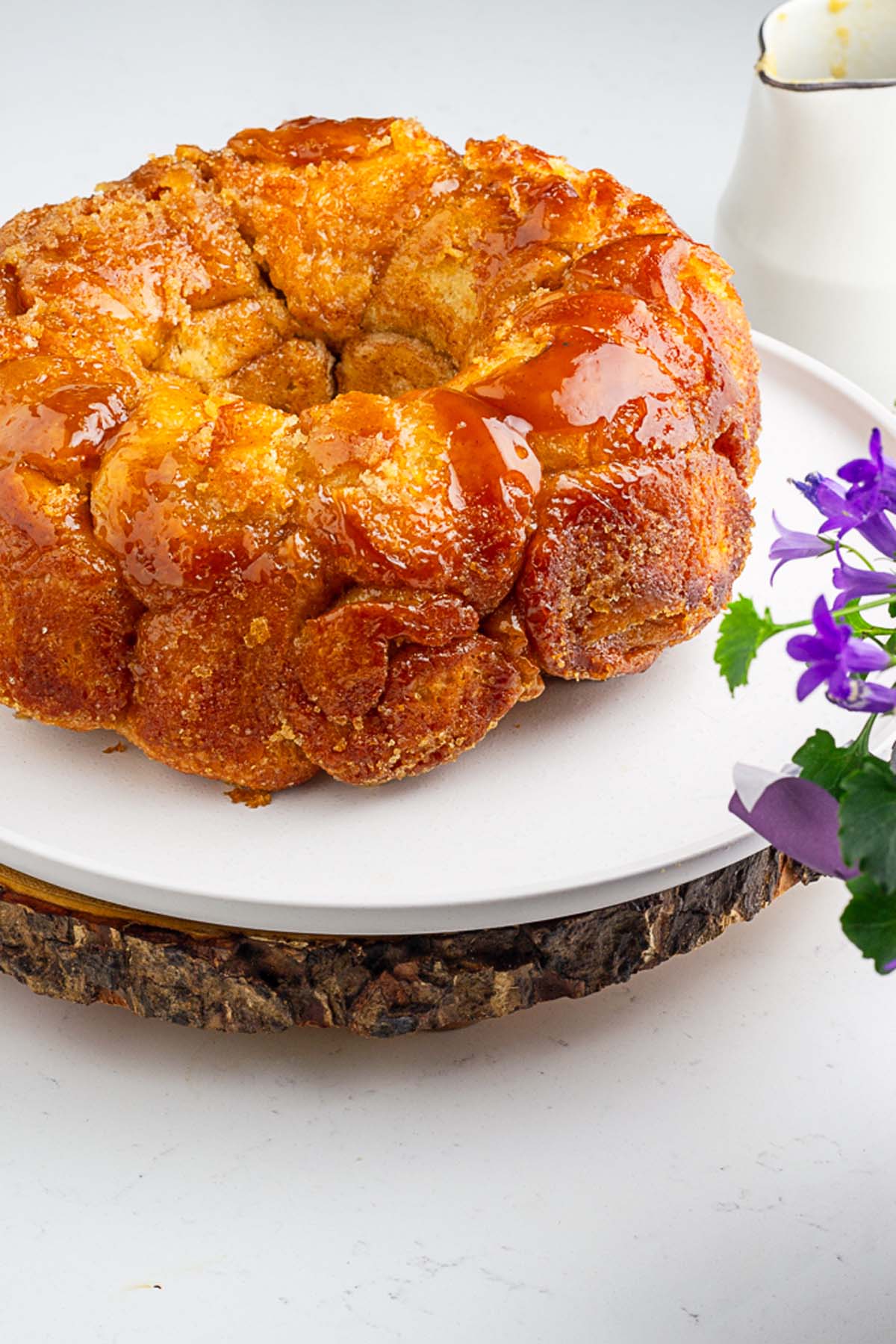
🔥 How to Reheat Monkey Bread
Monkey bread is best enjoyed warm—when the cinnamon-sugar glaze is sticky and the bread is tender and fluffy. Here’s how to reheat it without drying it out:
- Oven Method (Best for texture):
Preheat your oven to 300°F (150°C). Wrap the monkey bread (or individual pieces) in foil and heat for 10–15 minutes, or until warmed through. This method helps maintain the original texture and keeps the glaze from hardening. - Microwave Method (Quick fix):
Place a single portion on a plate and cover it with a damp paper towel. Microwave for 15–20 seconds. It’s fast and still tasty, but the glaze may be a bit stickier and the texture slightly softer.
Pro Tip: Add a tiny pat of butter before reheating to refresh the richness and keep it moist.
❓Frequently Asked Questions
Sourdough monkey bread requires more time than a typical yeasted dough because it relies on wild yeast from the starter. After mixing the dough, you’ll need to let it bulk ferment for 4 to 6 hours at room temperature, or longer if your kitchen is cool. Alternatively, you can ferment it overnight in the fridge (up to 12–16 hours), which enhances the flavor.
Once the dough is shaped into balls and coated in cinnamon sugar, a second rise is needed — this can take another 2 to 4 hours, depending on the temperature and the strength of your starter. To check if it’s ready to bake, gently press the dough; it should feel puffy and slowly spring back. Patience is key here — longer proofing results in a lighter, more flavorful monkey bread.
To keep sourdough monkey bread soft and gooey, store it in an airtight container at room temperature for up to 2 days. If your kitchen is warm, you can refrigerate it, but bring it to room temperature before serving for the best texture. To reheat, wrap individual portions in foil and warm them in a 300°F (150°C) oven for about 10–15 minutes.
You can also microwave pieces for 15–20 seconds, though the oven helps maintain the gooey caramel-like coating without making it rubbery. Avoid overbaking during reheating, as it can dry out the bread. For longer storage, freeze in portions and thaw overnight in the fridge, then reheat as needed. With proper storage, the sourdough flavor and moist texture stay delicious for days!


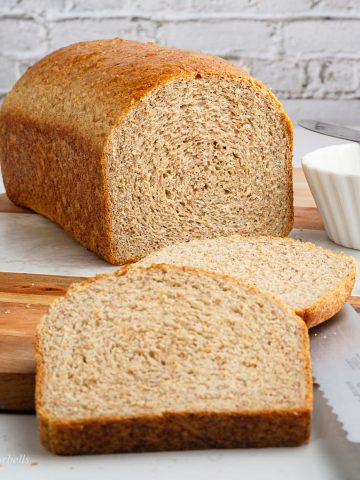
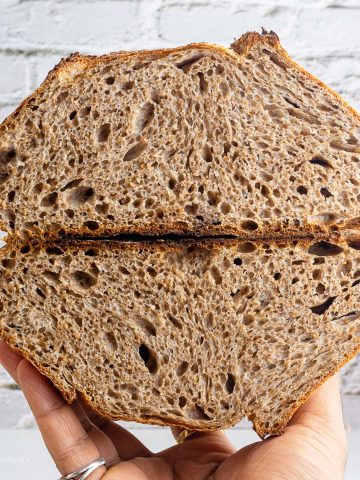


Leave a Reply